Princeton Magazine Article: Conquering Clutter
May 2009
Modernist Architecture cuts a clean silhouette against the Princeton horizon
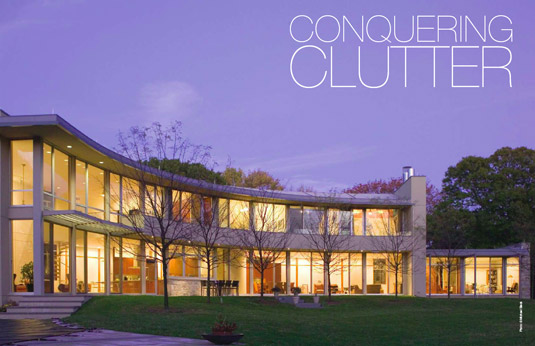 “Conquering Clutter” is admiringly appropriated from an article published in the New York Times from May 1981 that was written by Ada Louise Huxtable. You may recall the name. She was, for nearly a half century, the outspoken yet venerable architecture critic cum diva for the New York Times (and now at age 87, holds that post for the Wall Street Journal). Fearless in her architectural criticism, she delivered storied accounts of high art and outrageous messes with equal measure of intellectual ardor and pithy sentiment that made her a legend among her devotees. Through the lens of contemporary culture Ms. Huxtable made architecture a part of the collective conscience and public debate, invoking its value to a world forever changing. In the article she states that there are two kinds of people: those who like to live with clutter (life’s innumerable accumulations that represent memories, status and happiness) and those that edit their stuff down to the bare necessities in favor of the uncluttered space that remains. The reader is left to understand that it’s in this dichotomous distinction that Modernist houses have been conceived and have found their proud owners.
“Conquering Clutter” is admiringly appropriated from an article published in the New York Times from May 1981 that was written by Ada Louise Huxtable. You may recall the name. She was, for nearly a half century, the outspoken yet venerable architecture critic cum diva for the New York Times (and now at age 87, holds that post for the Wall Street Journal). Fearless in her architectural criticism, she delivered storied accounts of high art and outrageous messes with equal measure of intellectual ardor and pithy sentiment that made her a legend among her devotees. Through the lens of contemporary culture Ms. Huxtable made architecture a part of the collective conscience and public debate, invoking its value to a world forever changing. In the article she states that there are two kinds of people: those who like to live with clutter (life’s innumerable accumulations that represent memories, status and happiness) and those that edit their stuff down to the bare necessities in favor of the uncluttered space that remains. The reader is left to understand that it’s in this dichotomous distinction that Modernist houses have been conceived and have found their proud owners.
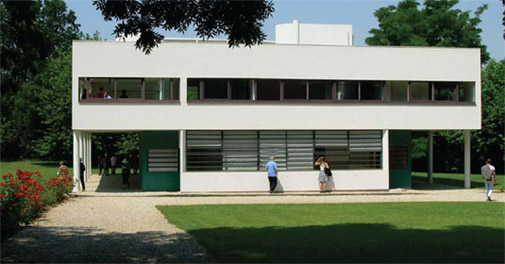
Villa Savoye designed by Charles-Edouard Jeanneret, better known as Le Corbusier, built between 1928 and 1931 in Poissy, France.
The clutter-free aesthetic is if nothing else an acquired taste. And like routine physical exercise or remembering to bring your own eco-bags to the supermarket, it requires a certain discipline and commitment. It’s not for everyone. And yet, Modernist inspired houses are back in vogue and growing in popularity, even in Princeton.
The Modernist movement began in the nineteen twenties and thirties when creative intellectual fervor became the tipping point in making social reforms in a war-torn Europe. This was a culture of change and the period in art history marked by the Cubists including Picasso, George Braque and Juan Gris. Among artisans and architects, the unbridled hope and idealism for a better world took shape at the Bauhaus; the uniquely endowed institute whose founders constitute the modern architecture hall of fame: Walter Gropius, Le Corbusier, and Mies van der Rohe. The Bauhaus, and for that matter Modernism, was founded on the principle that functional design could be mass-produced. This was the beginning of the anti-clutter epoch also known as the Modernist movement.
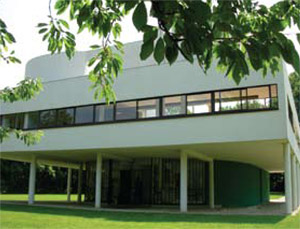
View of the entrance façade.
Le Corbusier called the house a box in the air. Through the use of stilts the base of the house dematerializes creating the impression of a house that floats above the ground.
It was considered radical at the time. Houses were designed with a social agenda to bring better living standards to the masses. Domestic architecture became the crucible for testing ideas about form, materiality, and the abstraction of surface into a practical means for negotiating spatial realities and perceptions of outside and inside. Architecture became art.
Functional space was reduced to practical minimums yet conceived as fluid, asymmetrical and dynamic with two story openings, balconies, ramps and internal stairways sky-lit from above. The uncoupling of the structural frame from the building walls had a liberating effect on the design. Large, continuous windows, even walls of glass illuminated the interiors and all but replaced wall art with views of the sky and landscape. Garden terraces for dining or just hanging out transformed rooftops into usable space. The conventional spatial hierarchy of the past had been turned on its head inspiring a new kind of stage for the performance of living. Eventually, these principles would be borrowed and elaborated upon by architects here in the United States including Frank Lloyd Wright, Marcel Breuer and Richard Neutra.

The “hanging garden” brings daylight into the center of the house and extends the footprint of the living areas.
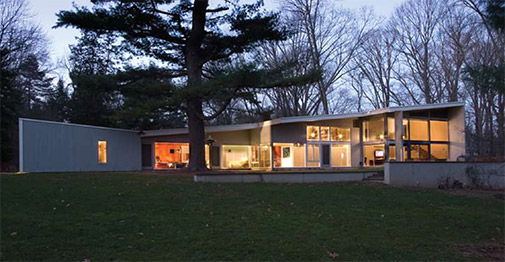
From the private garden, the glass walls allow the linear arrangement of living spaces to become one with the natural landscape.
The Lauck House designed by Hungarian-born Marcel Breuer was built in 1953-54 when post WWII America was searching for the affordable family house for the suburbs. Breuer’s open plan, butterfly roof and bi-nuclear arrangement of living and sleeping rooms generated intense debate in the newspapers of the day.

Left: The children’s playroom / study is connected to the kitchen, main living room and play yard. Right: The new owners, both architects, lovingly restored the beautiful natural materials used throughout, which are typical of Breuer’s houses.
The modernist legacy is culturally generative and rapidly evolving beyond the flowing spatial compositions of plan to three dimensional sculptures without right angles.
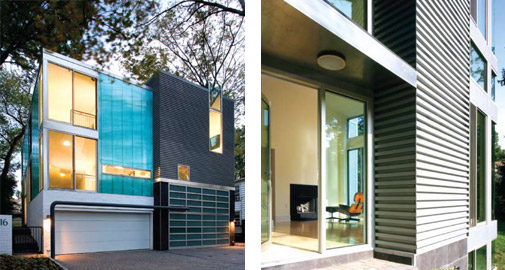
Left: Bowing to contemporary lifestyles and the urban context, the asynchronous pair of dwellings push the living areas up above the garage level where privacy, views, and daylight are optimized. Right: Spare of clutter and ornament, the clean geometries are expressed through common, low maintenance materials.
As one of the original members of the Bauhaus, Breuer followed Gropius to Harvard and then opened an office in New York City. He was arguably the de facto leader of the Modernist movement in residential architecture and gained prominence through his tubular steel chair designs as well as his early houses. He had a clear vision and as an academic and practitioner, lectured internationally to promote his theses. In 1948, the Museum of Modern Art chose Breuer to design an affordable family residence, which would be built to full scale for an exhibition called “House in the Museum Garden”. He saw this as an opportunity to make this a prototype design for future house commissions.
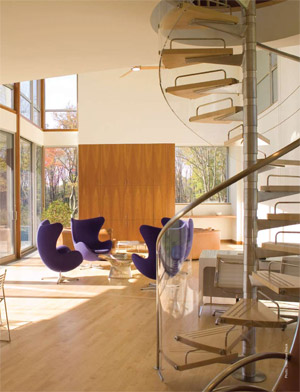
Architect Phil Holt designed this family residence, which was built by the construction firm Lasley Brahaney.
The first floor living spaces flow along a segmented glass arc that separates the interior from the stunning woodlands that surround the property. A custom-designed stair of stainless steel center column, cast glass balustrade, and solid maple treads appear as a delicate sculpture.
Breuer completed more than sixty houses over a period of some forty years. Three of these residential projects are in Princeton: The Lauck House (1953) and the Member Housing at the Institute For Advanced Study (1954-1957). The Lauck House, also referred to as ‘House in the Garden’ for its conceptual and historical likeness to the prototype in the MoMA exhibition, was recently restored and renovated by its new owners; architects Rafi and Sara Segal. (The Museum mounted a variant of the House in the Garden exhibition in 2008 called “Home Delivery: Fabricating the Modern Dwelling” which you can see on the MoMA website)
New modern houses are generating a buzz around town. Here are two that are worth knowing. The first is a duplex on Quarry Street designed and built by local architect J. Robert Hillier. Widely published in the architectural journals, this double dwelling is a sleek pairing of a Tiffany-blue box with a taught ribbedmetallic box as an abstract reinterpretation of the residential typology.
The luminous exterior, punctuated with big window openings and skylights, encloses a sunlit-washed two story living space with proportions that echo those of an urban loft. Here architecture recedes to a role of dramatic backdrop rather than being a prescriptive living arrangement.
The second house occupies a lovely wooded site in Princeton Township. Local architect Phil Holt designed a modern family residence that provides for trikes, pets and foosball in an environment with grown-up sophistication.
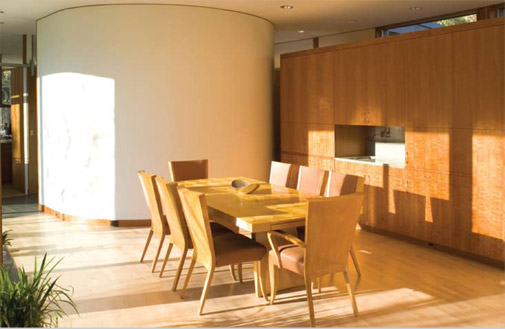
The dining room and kitchen are partitioned with objects that take the form of storage cabinets that sit below the ceiling plane. The surface materials, maple plank flooring and cherry veneer paneling on the walls, dramatizes the continuous planes and flowing space.
Responding to the high-canopied trees of the natural woodlands, the architect conceived the formal gesture for the house as a single, sweeping curve. The full height glass of the inner arc offers continuously changing light and views that can be had from all of the primary living spaces. A deep overhang extends out from the glass façade and acts as a passive solar device to reduce heatgain throughout the summer while allowing the low winter sun to warm the interior spaces. The landscape defines and contrasts this house not only through the sensitive planning and transparency, but also through the use of warm earthen colors and finishes that include natural maple flooring and cherry veneers. The children have the entire basement as a mini, astro-turfed arena where pintsized athletic events are held.
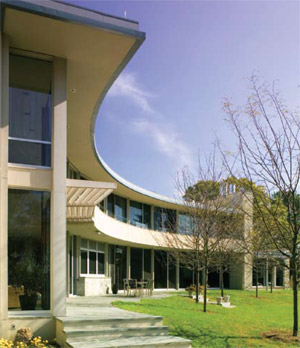
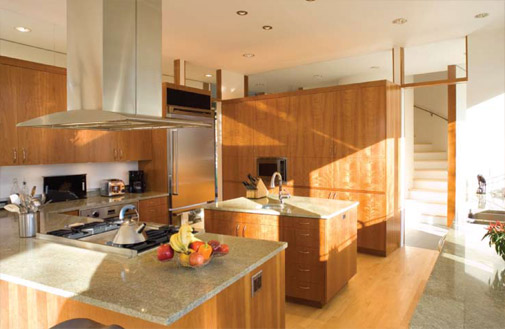
Spacious enough to accommodate helpers, the kitchen is a place of purpose and entertainment.
When asked about the Modernist influence on the design, Mr. Holt said that both he and his client shared a passion for the work of Richard Neutra and in fact owned the same monograph of his house designs: “That was the beginning of a great collaboration,” said Mr. Holt. He referred to the “spider leg” supports of the overhang and the stainless steel numerals that display the address as having been designed by Neutra, the latter of which came from Design Within Reach on Nassau Street. Joining the collaboration was the builder, Lasley Brahaney, a local husband and wife team with complementary professional backgrounds in architecture and construction. “The projects we enjoy constructing the most are those with the highest design aspirations,” said Mr. Brahaney. Ms. Lasley expressed her joy in having had the opportunity to help realize the creative vision of Mr. Holt and referred to him as a “benevolent patriarch.”
Among Princeton’s many assets is the panoply of architectural achievements including custom tailored houses designed by many respected and internationally recognized architects. While some houses model their modernist genes as stylish upgrades from within, an increasing number are strutting their lineage as unselfconsciously as the contestants on the TV weight loss reality show, the Biggest Loser. Proud to show off their refined, slim-downed silhouettes and sleek flat rooflines, modern houses are finding greater acceptance here and elsewhere because in their unapologetic, uncluttered matter-of-factness, they convey the simple, sustainable art of living in today’s changing world.
- written by Barbara Hiller AIA
All content used with permission © 2010 Princeton Magazine





